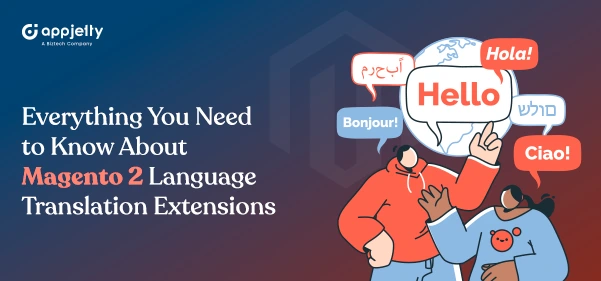If you run a Magento store in the global marketplace today, you should be prepared to speak to your customers in their own language!
Whether you’re a store owner with a business expansion to new areas, a marketing lead hoping to increase conversions, or a developer looking to provide a great multi-language experience, the right language translation extension may be your most important decision.
With so many options out there, it can be difficult to determine what, if any, tool will be reliable, easy to use, and suited to your store’s unique and varied needs. In this blog, we will provide everything you need to know about Magento 2 language translation extensions, including what they do, why they are important, and which ones you may want to pay attention to.
We want to help you build a store that can speak to anyone, regardless of where they are shopping!
What Are Magento 2 Language Translation Extensions?
Magento 2 Language Translation Extensions assist store owners in changing the language of their website content. Store owners can build custom language translations for product descriptions, CMS pages, buttons, checkout labels, and more by translating them manually or using services such as Google Translate or AI-based engines.
They simplify the translation process for non-technical users by offering a user-friendly interface and bulk translation process. Developers can use APIs and customization capabilities to develop translations for large-scale multilingual system setups.
These tools can find and translate your store’s text and set a translation layer rendered per each language view.
In the end, everything leads to a hassle-free shopping experience for users anywhere around the globe.
Why Language Translation Matters in Magento 2 Stores?
Speaking your customer’s language is more than a convenience—a competitive advantage.
Language translation in Magento 2 plays a significant role in building strong relationships with global audiences. The right tools and strategy can enhance the user experience, expand your reach, and increase conversions. Here’s why it truly matters:
1. Customer Experience & Trust
Visitors are more comfortable when the store communicates in a language they understand. It builds instant trust and helps them feel more connected to the brand. A familiar experience makes it easier for customers to navigate, browse, and purchase confidently.
Big names like Zalando offer content in multiple European languages to create a personal and relatable shopping experience for users across different countries.
Magento 2 translation extensions help translate content and overall tone, ensuring the experience is seamless and localized for each visitor.
2. SEO Benefits of Localized Content
Multilingual content improves the site’s presence in local search results. Magento 2 translation tools support SEO elements like hreflang tags, localized meta descriptions, and clean URLs.
For example, Booking.com ranks well in different countries by offering region-specific language pages optimized for local search engines.
Proper translation increases visibility, drives organic traffic, and ensures your store ranks high across multiple markets.
3. Conversions, Accessibility, and International Expansion
A well-translated store removes language barriers that often lead to cart abandonment. Customers are more likely to complete a purchase when they fully understand product details, shipping info, and return policies.
Magento 2 extensions also improve accessibility for users who may not speak English as their first language.
AliExpress, for instance, offers its platform in dozens of languages to support its massive global customer base and drive conversions.
4. Better Localization
Translation is just one part of localization. Magento 2 helps stores adjust language and cultural elements such as payment methods, shipping options, and imagery.
Localization helps stores follow country-specific rules and regulations, keeping businesses compliant and credible.
McDonald’s localizes its menus in each country—offering regional favorites like McPaneer in India or Teriyaki burgers in Japan—to meet local tastes and expectations.
Magento 2’s extensions simplify localizing language while adjusting region-specific preferences for a more relevant experience.
5. Ease of Use
Magento 2 translation extensions are built to be user-friendly, even for non-developers. Admins can manage translations directly from the backend, with options for bulk translation and language switching.
Just like Shopify’s translation apps offer simplicity for store owners, Magento 2 makes handling multiple languages more intuitive and time-efficient.
Language switchers, mass translation tools, and live preview features allow faster management without compromising accuracy or experience.
6. Improved SEO
Translated content doesn’t just improve user experience—it helps boost search engine rankings. Magento 2 supports SEO-focused translation extensions that ensure your multilingual content is crawled and indexed correctly.
Hreflang implementation ensures search engines deliver the right version of your site to the right audience.
Brands using this approach, like ASOS, experience improved discoverability in international markets.
Magento 2 extensions help you rank for keywords in various languages and show up in regional search engines—not just Google.
7. Comprehensive Control
Magento 2 gives store owners complete control over translation workflows. Store admins can track, edit, and approve translations without relying on external systems.
Extensions store translation memory, reducing redundancy and maintaining consistency across all content.
eBay provides central translation tools to sellers for consistent product listings across regions.
Magento’s centralized approach ensures that all translated content remains uniform and aligned with your brand tone, regardless of how many languages you support.
8. Increased Customer Loyalty
When customers feel understood and valued in their native language, they’re more likely to return. Language builds emotional connections, and that connection drives loyalty.
For instance, Netflix personalizes content and language settings based on region, keeping users engaged and returning.
Magento 2 helps store owners do the same—by offering language-specific product suggestions, promo messages, and localized experiences that resonate.
Personalized, language-aware communication helps turn one-time buyers into repeat customers who feel at home in your store.
Thus, localization isn’t just about translation—it’s about creating a store that connects with customers everywhere.
How to Set Up and Configure Magento 2 Language Packs for Global Stores?
Setting up a multilingual store in Magento 2 involves a few core steps. Here’s how to do it:
Step 1: Install Language Packs
Start by installing the necessary language packs for the languages you wish to support. Magento provides language packs that can be installed in two ways:
- Via Composer: Use Composer to install official Magento language packs for your desired languages.
- Manually: You can also manually download and install language packs, depending on the language you want to add.
Language packs translate default Magento interface elements like buttons, labels, and links into the selected language.
Step 2: Create Store Views for Each Language
Once you have installed the language packs, you must create store views for each language. This ensures that each language has a dedicated view for customers to select.
1. Log in to your Magento Admin Panel.
2. Navigate to Stores > All Stores.
3. Click on Create Store View.
4. Fill in the required information:
- Store: Select the parent store.
- Name: Enter the name of the store view (e.g., French, Spanish).
- Code: Provide a unique code (e.g., French, Spanish).
- Status: Set the status to ‘Enabled.’
- Sort Order: Define the display order of the store view.
5. Click Save Store View.
Step 3: Configure Locale Settings for Each Store View
To ensure proper language and formatting, you need to configure the locale settings for each store view:
1. In the Admin Panel, go to Stores > Configuration.
2. Select the store view you want to configure in the top-left corner.
3. Under the General tab, click on Locale Options.
4. Set the Locale to the desired language for the store view.
5. Click Save Config.
Step 4: Translate Store Content
With store views and locales set, the next step is to translate your store’s content:
- Products and Categories: Assign products and categories to the appropriate store views and provide translations for their names and descriptions.
- CMS Pages and Blocks: Create separate CMS pages and blocks for each store view, including translated content.
- Email Templates: Duplicate email templates for each store view and edit their content to reflect the translated text.
Step 5: Deploy Static Content for Multiple Languages
After you have completed your translations, you need to deploy static content for each language. This applies the translations to static content like CSS, JavaScript, and images.
Step 6: Test and Refine Translations
Finally, after deploying your language packs and content, it’s time to test your translations:
- Navigate through your store’s front end and use the language switcher to toggle between languages.
- Verify that the translations appear correctly and that the content is properly localized.
- Adjust translations via the Admin Panel to ensure consistency across your store.
Thus, following these steps allows you to install and configure language packs, providing a localized experience for global customers.
NOTE: For more in-depth information and detailed instructions, please refer to the PDF.
Top 5 Magento 2 Language Translation Extensions (2025 Edition)
Choosing the right Magento 2 extension can be tricky, with dozens of translation tools available. We’ve done the research to help you make a confident choice.
1. AppJetty’s Magento 2 Language Translator Extension
AppJetty’s Magento 2 Language Translation extension is a robust extension that simplifies the translation of product details, CMS pages, and category content. Designed for technical and non-technical users, it supports manual and automatic translations and works seamlessly with multiple store views.
Features and Benefits:
- Google API integration for auto-translation
- Translate products, attributes, and CMS blocks
- Bulk translation feature to save time
- Inline editor for quick content updates
- Supports multiple languages and stores views
- User-friendly interface for non-dev users
2. Magefan’s Magento 2 Translation Extension
This extension lets you directly translate labels, buttons, phrases, products, categories, and CMS content from the admin panel.
Features and Benefits:
- Auto-search for texts available for translation
- Translation in one grid
- Translation of products and categories via a translation form
- Import/export of translations via CSV or XML
3. LangShop by Aheadworks
LangShop is a comprehensive translation solution that supports 247 languages and dialects. It offers AI-based translations and integration with professional translation services.
Features and Benefits:
- AI machine translation, manual, pro (Google Cloud Translation, DeepL Pro Translation), and agency translation options
- Glossary for accurate translation results
- Bulk translation capabilities
- Translation suggestions to enhance accuracy
4. Mageplaza’s Language Pack
Mageplaza offers free and premium language packs, facilitating quick language setup and supporting SEO localization.
Features and Benefits:
- Supports 75+ languages
- Easy integration with Magento 2
- Great for SEO localization
- Lightweight and fast performance
5. Webkul’s Language Translator for Magento 2
This extension enables auto-translation of store product and category attributes using Google Translator, enhancing multilingual support.
Features and Benefits:
- Multi-language store translation
- Translation functionality for admin product and category attributes
- Attribute label translation on save
- Mass action for attribute label translation
The best extension depends on your store size, budget, and technical skills, but one thing’s clear: the right tool can significantly simplify your multilingual journey.
6 Best Practices for Using Translation Extensions in Magento
Using a translation extension is just step one—applying best practices ensures a smoother, more effective localization strategy.
1. Keep your SEO intact while translating
Ensure that translated pages include proper hreflang tags, meta titles, and descriptions. Many extensions handle this automatically but double-check to maintain your search visibility across regions. Also, avoid duplicate content issues by assigning the correct language-specific URLs and ensuring search engines understand your site structure.
2. Test translations before going live
Always preview your translations before publishing. Check product pages, checkout flows, and CTAs to ensure everything looks natural and functions properly. Even small mistranslations or layout shifts can confuse users or break trust—so involve native speakers or QA testers when possible.
3. Don’t overlook checkout, buttons, and error messages
Small elements like “Add to Cart,” “Out of Stock,” or system errors can hurt UX if left untranslated. Use extensions that cover all dynamic and static content. Ensure every customer touchpoint—especially the purchase path—is clearly understood, regardless of language.
4. Maintain consistency in tone and product details
Use glossaries or translation memory options to ensure your terminology and brand voice remain consistent across all languages. Inconsistency in language can lead to confusion or professional writing in areas that require accuracy (such as technology and health or fashion).
5. Use fallback languages smartly
If a translation is missing, show the default language instead of an empty field. This ensures users still see content rather than broken experiences. You can also configure custom fallback logic to prioritize regional dialects or similar language groups when appropriate.
6. Keep translations in sync with store updates
Whenever you add or update products, make sure translations follow. Some extensions can automate this or notify you of untranslated content. It’s easy to forget translations when launching new collections or promotions, so having a content-sync process helps maintain a polished experience.
Overall, good translation practices keep your multilingual store functional—but trustworthy, scalable, and user-friendly.
Final Words
Language should never be a barrier to making a sale. Magento 2’s translation extensions help store owners localize their websites, enabling them to reach global audiences. Marketers can enhance SEO and conversion rates through localized content. Developers benefit from scalable and cost-effective solutions for implementing multilingual support.
If you are beginning your expansion or you have a store that already includes different languages and you are optimizing it, the first decision you will need to make is which extension is right for you.
Let your store communicate in your customers’ language—no matter where they might be!
All product and company names are trademarks™, registered® or copyright© trademarks of their respective holders. Use of them does not imply any affiliation with or endorsement by them.
Frequently Asked Questions
1. Do I need a separate extension for each language?
No, most Magento translation extensions support multiple languages within one system. You can manage all translations centrally, making scaling and localizing for different markets easier.
2. Will my store performance slow down?
Not necessarily; high-quality translation extensions are built to be lightweight and optimized. However, always choose tools compatible with your Magento version and test performance post-installation.
3. Can I edit translations manually after using an extension?
Yes, most extensions allow you to override auto-translated content. You can fine-tune language to preserve brand voice and product accuracy, especially when AI-generated translations miss cultural nuances.
4. Is it compatible with Magento 2.4.x?
Leading translation tools are regularly updated to remain compatible. Always check the extension’s documentation and user reviews before installing Magento 2.4.x to ensure smoother installation and better long-term support.
5. Are translation extensions SEO-friendly?
Yes, if configured correctly. Look for extensions that support hreflang tags, localized URLs, and meta translations. Proper setup helps your translated pages rank in country-specific search engines.





